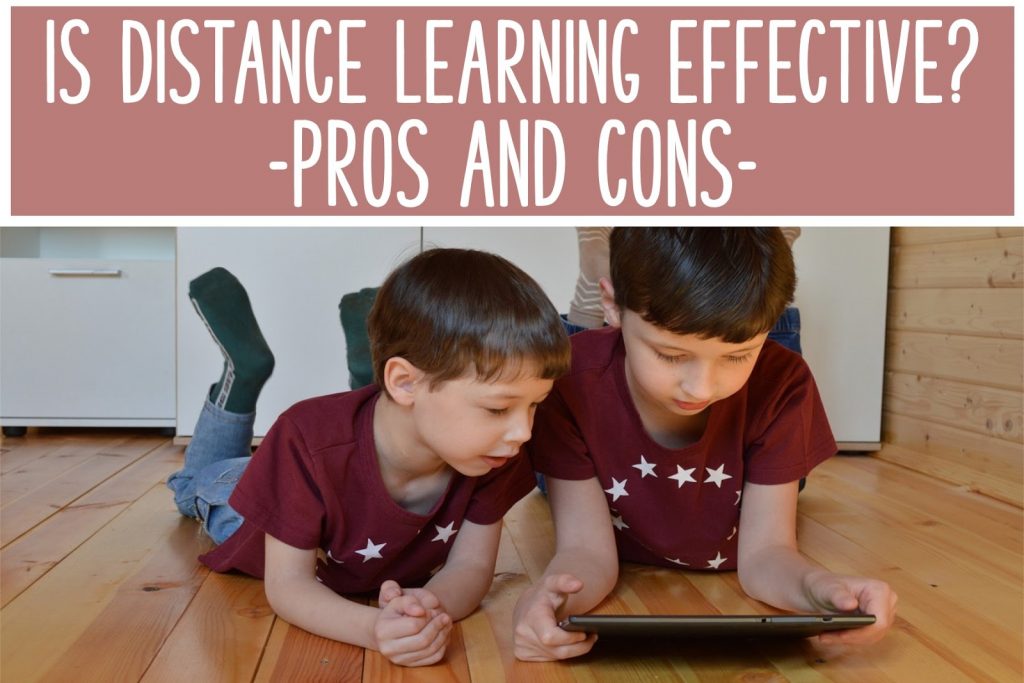
We’ve all been tossed out into the virtual world. Virtual (online, distance) is a different platform that is intuitive for some teachers and students but problematic for others. It’s left all of us wondering if distance learning is effective? Let’s take a closer look at the pros and cons of distance learning for teachers and students.
Pros: Flexibility
TEACHERS
Theoretically, you have the flexibility to prepare ahead of time, but there is always an obstacle in the physical school building. Copiers get jammed or last-minute copies need to be made. After another million distractions, you are too often running just ahead of the class session. Distance learning allows you to prepare the work ahead of time and make adjustments whenever you want! You can work according to your own schedule, whether you’re a night owl or an early bird.
Many teachers are also allowing for assignment flexibility, which has made an impact on students.
STUDENTS
In addition to flexibility for you as a teacher, distance learning also allows for increased flexibility for your students. Students have the flexibility to access materials when they want to, which allows for increased productivity. Some students seem like geniuses at 10 pm when they could barely function in the classroom at 10 am. This flexibility works so well for so many students.
Cons: Flexibility
TEACHERS
On the other hand, you may have to prepare more work now, which takes more time and adds to your workload. You can prepare in bulk, but you still have to be available for that increased flexibility for each student and in many cases, their parents, too! Of course, you have administrative mandates on top of your teaching mandates. Many teachers are left feeling like they’re being pulled in so many different directions from work and family. Working from home means we are constantly in the same world: live, work, and function in our homes. Best of all, teachers have the flexibility to try new things such as Digital Escape Rooms to help students think critically while at home.
Many students are sharing these feelings of being overwhelmed, and for some students, flexibility leads to more problems than benefits.
STUDENTS

Your students live by routine. The majority of our lives are carved by routine even as adults. For young, developing minds, flexibility means a lack of control. Instead of completing work at an alternative time, some students are not completing work at all. For those students, flexibility means they are not accessing materials, and for many, there is no guidance at home that helps them understand deadlines. Flexibility often removes the expectation of responsibility, and we are seeing that with distance learning.
Pros: Distractions
TEACHERS
You are faced with distractions daily: other teachers, administrators, students, meetings. There are so many distractions. Now, you are able to be at home with your family. It’s so nice to be able to use the bathroom when you need to go. The reality is that our families are also distractions, but they’re the distractions we love.
For students, the distractions can be less at home.
STUDENTS
Consider all the distractions in front of students in a building: friends, bullies, status. There are factors in the building that most teachers do not think about daily. Your students do. When asked what the best thing about distance learning was, one student (Wyatt Brandon, freshman, 15 with special needs) said, “Safety. I don’t have to worry about bullies.” Despite a world of love and support, your students are faced with distractions daily at school. Distance learning gives them an opportunity to feel safe from others and safe from distractions.
Cons: Distractions
TEACHERS
As much as we love our own families, they can be a distraction. So are the mound of dishes and the pile of laundry staring at us, pleading to be cleaned. These distractions can include doing what we love over what we need to complete. It’s hard to stay motivated to do something when other things are distracting you.
STUDENTS
Students are also struggling with distractions of their own. Think about the kid who sits in the front of every physical classroom. They zone out everything behind them. Even the kid who sits in the back only has to see everything in front of them. With distance learning, distractions are everywhere especially in the online meeting platforms like Zoom or Google Meet. These platforms can be difficult for students. They sit in front of a screen that requires more focus and attention than a traditional environment, and there are so many distractions on and off-screen. For example, seeing all aspects of everyone on screen, keeping up with who is talking, trying to figure out the technology, and everything outside the screen at home can be difficult. Factor in any technical issues and student motivation can decline. Distractions are a large factor in why distance learning isn’t for everyone.
[“source=virtualwritingtutor”]





